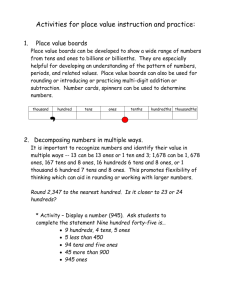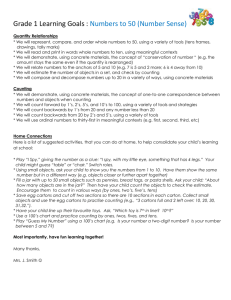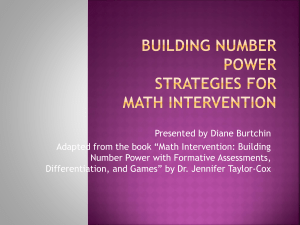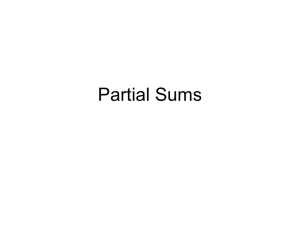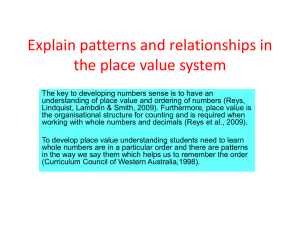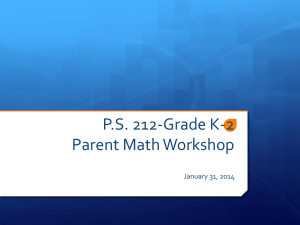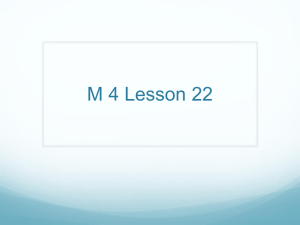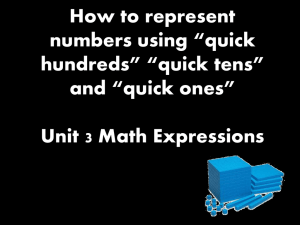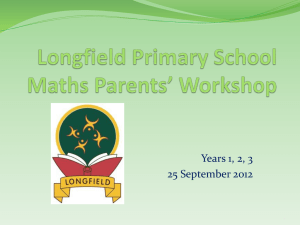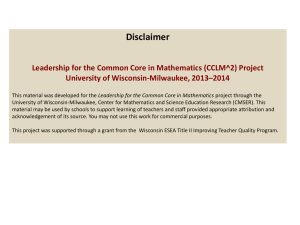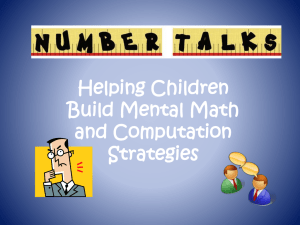Key stage 1 Place value and the number system
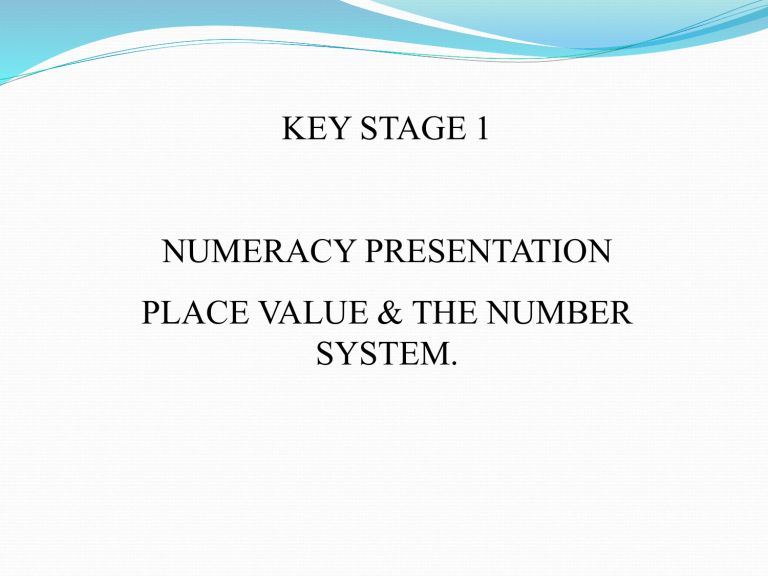
KEY STAGE 1
NUMERACY PRESENTATION
PLACE VALUE & THE NUMBER
SYSTEM.
LOOKING AT THE NUMBER SYSTEM.
1 2 3 4 5 6 7 8 9 10
10 20 30 40 50 60 70 80 90 100
100 200 300 400 500 600 700 800 900 1000
Our number system is based upon a decimal system, where we have only 10 different digits 1-9 and 0, where it is especially important to understand 0 as a place value holder.
OBJECTIVES FROM THE HALF TERM PLANS.
These can be divided into the following categories:
- Counting and properties of numbers
- Number sequences
- Place value and fractions
- Ordering, estimating and rounding
ACTIVITIES TO ASSIST YOUR CHILD.
Counting and properties of numbers:
Count 20 objects spread out, close together, stacked up, rearrange and count again- is the number of objects still the same?
Count steps across the room, beats of a drum.
Count objects by grouping in tens, then fives or twos.
Count from 30 to 70 how many tens did you count?
Write the next 3 numbers & describe the sequence: 34, 44, 54...
Start at any number count on from this number in ones.
Count on 40 from 30 then 27 etc.
ACTIVITIES TO ASSIST YOUR CHILD.
Fill in numbers on a number track- count on and back.
4 5 6
Look at different ranges of numbers:
37 38 39
Look at different number patterns:
44 54 64
SOME DIFFICULTIES & MISCONCEPTIONS.
Not counting the actual number of objects but referring to the size of a group of objects.
Consistency when counting in steps of any size- this covers physical skills of counting accurately and the knowledge when counting in number patterns.
Crossing the tens boundary- what number comes after 19?, 69?
Problems with counting on or back. Physical skills as well as an understanding of when to count on and when to count back.
Problems with counting in patterns- this is something they need to know- lack of retention/ knowledge.
Counting in tens from a number with units- applying a concept.
ACTIVITIES TO ASSIST YOUR CHILD.
Number sequences:
Know the vocabulary odd, even, sequence, predict, continue.
Count rhythmically in twos to 20 and count back again. Repeat starting at 1.
Respond to questions such as what numbers come next:
2, 4, 6, 8 ? 15, 13, 11, 9 ? Describe these patterns.
Is 18 odd or even? How do you know? (It can be divided by 2)
Ring the even numbers: 5 8 19 22 31 46
What odd number comes after 13? After 7?
What number comes next? 16, 14, 12….. 5, 10, 15…..
Create a number pattern with the number 6 in it.
ACTIVITIES TO ASSIST YOUR CHILD.
Number sequences:
Describe each pattern, what is the rule?
3, 6, 9, 12….. 16, 14, 12, 10…..
Fill in the missing number in this sequence:
3, 6, ?, 12, 15
Understand and begin to read
‘multiple’
.
Recognise that multiples of 10 end in 0,
5 end in 0 or 5
2 end in 0, 2, 4, 6, 8,
Ring the numbers that are multiples of 10:
70 45 12 80 10 27
SOME DIFFICULTIES & MISCONCEPTIONS.
Understanding a range of vocabulary.
Heavily reliant upon knowledge of different counting sequences, odd and even numbers.
There are many different ways of phrasing questions and children need to be aware of a variety of different ways questions can be asked.
Be able to spot a pattern with numbers.
ACTIVITIES TO ASSIST YOUR CHILD.
Place value:
Know that 14 = 10 + 4 and 14 – 4 = 10.
Exchange amounts up to 20p ( 100p in year 2 ) for 10p and 1p coins.
What does the 1 digit in 14 represent? And the 4? ( They represent 10 and 4 )
Partition larger numbers: 34 = ? + 4, 42 = 40 + ?
What number is equivalent to six tens and four ones.
How would you change 49 to 9? Make 5 into 75?
Use of resources.
1 0 4 1 4
SOME DIFFICULTIES & MISCONCEPTIONS.
Many children find the concept of equivalence difficult- this means that they find it hard to understand that 10 units are equal to 1 ten. This is most evident when using money.
Mistaking tens and units in two digit numbers- this causes problems when partitioning numbers and when answering questions by reversing the tens and units- so an answer of 47 would read as 74.
Mistakes when adding tens and units.
Handling and using resources accurately.
ACTIVITIES TO ASSIST YOUR CHILD.
Fractions (Year 2):
1 2 3 4 5
5 ½
6 7 8
Ring half the shapes:
Explain why these are not divided into halves
Find half of a bar of chocolate in squares
Find one quarter of 12 biscuits.
Know ½ = 2 ¼’s and that 1 is bigger than ½ and ¼ etc.
9
SOME DIFFICULTIES & MISCONCEPTIONS.
Understanding fractions as splitting a whole into equal parts.
Know that ½ or ¼ is smaller than 1 whole one.
Know that 5 ½ is larger than 5 and smaller than 6.
Relating ¼ ‘s to time- ¼ past and ¼ to.
ACTIVITIES TO ASSIST YOUR CHILD.
Ordering, estimating and rounding:
Understand language of ordinal number- first, second etc.
Write a number on each blank card so that the numbers are in order:
15 19 22
85 91 102
Put a set of numbers in order largest (or smallest) first:
0
Estimate the position of these numbers on the number line:
10, 30, 50, 70;
20 60 80
Round these numbers to the nearest 10: 33, 37, 35.
Estimate a number of objects up to 30 ( 50 or more for year 2 ).
SOME DIFFICULTIES & MISCONCEPTIONS.
Children need to know the correct order again crossing the tens boundary is an example of this misconception.
Using knowledge and understanding of place to order numbers.
Know the associated vocabulary- for example placing a sequence of numbers in order smallest first .
Children need a large range of opportunities to estimate in many different contexts.
When rounding numbers understand the concept of finding the nearest ten or hundred by rounding up or down.
Know that a number with 5 units is rounded up.
SOME DIFFICULTIES & MISCONCEPTIONS.
To summarise general problems arise when:
- Children do not understand the relationship between 1, 10 and 100 and therefore don’t recognise that to add or subtract 10 or 100 is no more difficult than to add or subtract 1.
- Don’t recognise numbers which are 10, or a multiple of 10, apart.
- Don’t know the sequence of ‘teen’ numbers, which do not follow the structure of the number system.
- Reverse numbers- confusing the tens and units columns including partitioning.
- 0 as a place value holder.
- Tens and equivalent units - 10 units as 1 ten.
- Adding/ subtracting with tens and units- applying the use of place value.
- Crossing the 10s barrier- what comes after 39?, 69? 99? Etc.
TYPES OF QUESTIONS:
Questions are determined by how you would like your child to answer. There are two basic types of questions:
Open: Can you give me 3 even numbers?
This question has a wide range of answers.
Closed: Which even number comes after 8?
This question has only 1 answer.
Mixing open and closed questions: Can you give me 3 even numbers between 20 and 40?
This question has a limited range of answers.
HOW TO HELP YOUR CHILDREN.
1. Look at the half term plans for an objective.
2. Think of a relevant everyday activity that addresses this objective.
3. Ask your child how they worked out their answer.
4. Address any misconceptions.
5. Make it fun! If the child does not want to do the activity they will get very little from it.
6. Think about variety of questions and different contexts for your child’s work.
